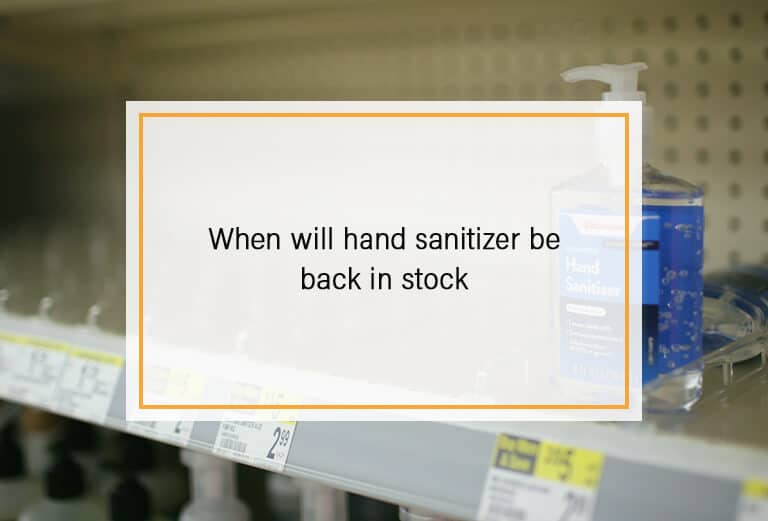
We know how extremely difficult it is to find hand sanitizers right now. Manufacturers around the world are working around the clock just to meet local demand. Even if tons of distilleries have joined the movement to make hand sanitizers, there wouldn’t be enough stock for every local citizen.
So you may ask when are we supposed to get hand sanitizers for every member of the household?
Hand Sanitizers will be difficult to buy for a long time

Source: The San Diego Union Tribune
According to many hand sanitizer manufacturers, it may take them a long time before filling in the public’s demand. That’s because healthcare workers and frontliners are given priority when it comes to the supply of hand sanitizers, alcohol, face masks and other medical products.
And whatever inventory is left would finally go to consumers. But the inventory is not enough for everyone.
But why is there a Hand Sanitizer Shortage anyway?
Now, there are a lot of factors which make hand sanitizers hard to find.
1. Hand Sanitizers are one of the most in-demand products during the Covid-19
First, you must have heard about panic buying, stockpiling and price gouging. Ever since the global pandemic hit, people have had the urge to get essential resources for protection.
The World Health Organization (WHO) points out effective ways to protect yourself from COVID-19. The most essential thing to do is to wash your hands with soap and water. If you’re not near the sink, you can use alcohol-based hand sanitizers to rid your hands from the virus.

Source: BeCleanse
Because of the fear of contracting the disease, hand sanitizers, disinfectants, tissues and cleaning detergents have been stockpiled. Some nasty opportunists even hoarded products from Amazon just to sell them at a horrendous price.
In every country, the government only allowed a limited amount of hand sanitizer bottles to be purchased for every household.
Before the outbreak, manufacturers supply 3 billion litres of hand sanitizers a year. Now the WHO projects that we need about 2.9 billion liters in a month. That’s about 35 billion liters a year! Some experts say it accounts for 1,400% under supply.
2. Limited Raw Materials
According to the Center for Disease Control and Prevention (CDC), hand sanitizers can only be effective at killing Coronavirus when it contains 60% ethanol or 70% isopropanol.
So an Alcohol-based Hand Sanitizer has an active ingredient which is alcohol.
In making alcohol hand sanitizers, ethanol is started off at 96% volume content. It will then be diluted with other ingredients such as glycerol, hydrogen peroxide, emollients and fragrances until it reaches 60-80% concentration.
From here, we can see that manufacturers need a couple of ingredients for making hand sanitizers. Each ingredient is usually acquisitioned from different companies or outsourced from China or other countries.
And this makes it difficult for a hand sanitizer manufacturer to make the product if one supplier fails to deliver items.
As the CEO of QYK Brands says, there’s not enough chemical compound supply to make the hand sanitizer gel.
Even though suppliers are manufacturing at full capacity 24/7, it will be very difficult to meet the demand.
3. Limited Plastic Bottle and Pump Head Dispenser Production
With the sudden increase in demand, plastic bottle manufacturers are also doing their best to cope up with the numbers. Plastic bottles and pump heads are usually made from polyethylene terephthalate or PET.

Source: Dreamstime
The supply of pump head dispensers for sanitizers have been outgrown by the demand. Hence, there is also a short supply of containers for hand sanitizers.
Not to mention, many of these plastic containers are being outsourced from China and Italy. These countries were badly hit by the Coronavirus. This has further caused a shortage of pump bottle supplies for other countries such as the UK and USA.
But it’s not only the short supply problem that we are concerned about. It’s also the sustainability and environmental concerns brought about by the number of bottles being produced and the pause in the process of recycling facilities.
Currently, there is a growing concern about the uncertainties caused by the pandemic. Waste management facilities are also not being able to process waste plastic bottles in the proper manner.
In fact, 85% are being directly incinerated even though some plastics can still be brought back to the supply chain.

Source: National Geographic
In the UK, concerned parties put out a call to recycle hand sanitizer bottles to reduce plastic waste consumption. Manufacturers also recommend ordering in bulk or large refill containers.
In this way, people can help reduce plastic waste and hasten the deliveries as hand sanitizers will be delivered in tanks or large container refills.
4. Issues on Logistics and Export Movement
In the USA, hand sanitizer companies, such as GOJO, have asked the president for a China tariff relief amid shortages. This will help these companies produce more hand sanitizers at a faster rate.
With the ongoing lockdown, there’s also the difficulty in the movement of goods from one country to another. Each step of the way from manufacturing to packaging to transportation and distribution can be affected by tariffs and logistic policies from different countries during Covid.
China is Getting Up Ahead in Hand Sanitizer Manufacturing
Meanwhile, China has ramp-up hand sanitizer production as it’s recovering from the Coronavirus outbreak. Hand sanitizer factories and raw material exporters have started mass production again.
BeCleanse, a China hand sanitizer manufacturer, has now over a million hand sanitizers with 75% alcohol in its inventory. The company also offers their products at a very low price per piece.

Source: Amway Global
Conclusion
Hand sanitizers are highly in-demand and are hard to find nowadays. Hence, it is better if you can import these products from China as early as you can. Inventories will not last very long as people are sweeping off these items fast. But remember to order just enough hand sanitizers to fill a demand, and not to hoard products for selfish reasons.




